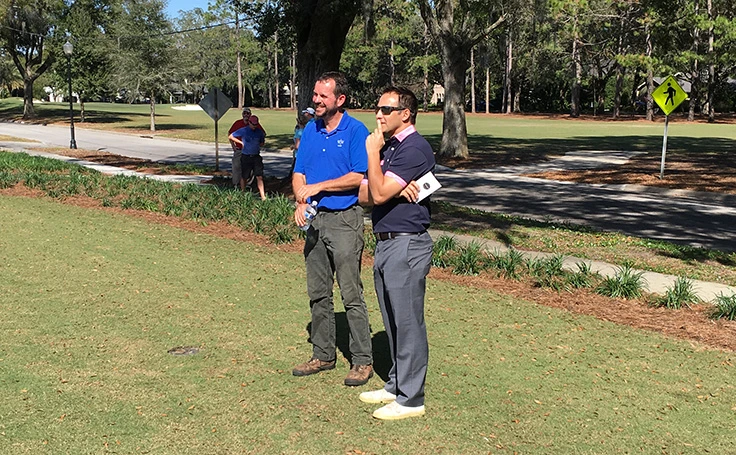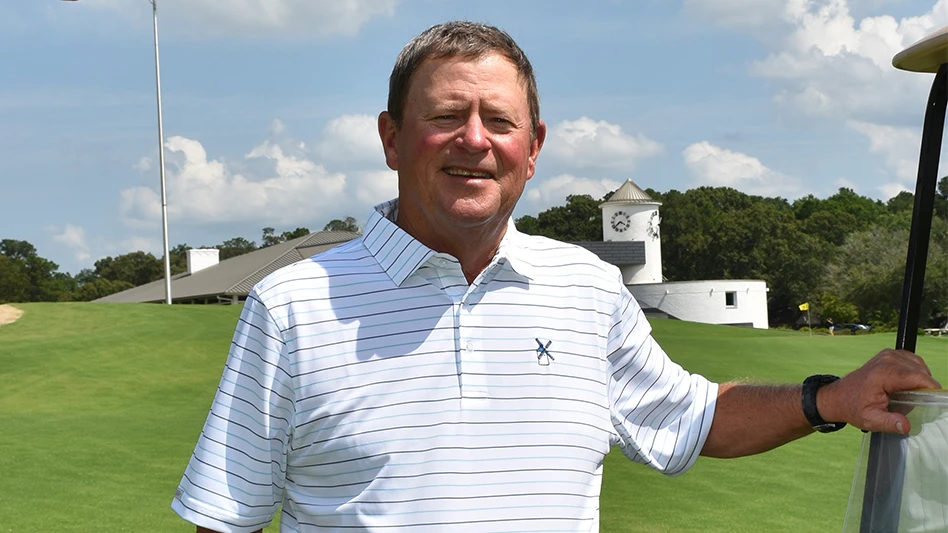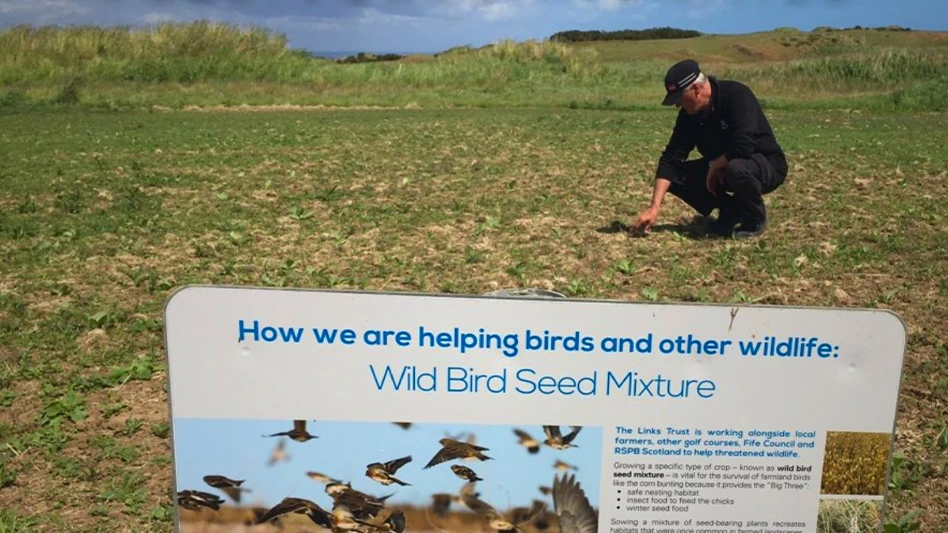
Ed Batcheller doesn’t maintain an 18-hole golf course. He has four co-workers and they must dodge automobile traffic to reach job assignments. His office rests between a par 5 and cemetery. Mondays can be as busy as Saturdays and Sundays.
In an industry where big and gaudy are often celebrated, Batcheller receives the daily fulfillment of overseeing the transformation of a city-owned course tipping out at 2,480 yards.
(Pictured: Winter Park Golf Course superintendent Ed Batcheller, left, chats with agronomist Adam Calver.)
Batcheller is the superintendent at Winter Park Golf Course in Winter Park, Fla.
The nine-hole facility reopened last October after a 31-week renovation. Golfers on the first tee and the final green of their careers – and players at every stage in between – are visiting the revamped course.
Efficiency, ingenuity, cooperation and dedication created a product being enjoyed by all. Established in 1914 and played by Gene Sarazen, Walter Hagen, Ben Hogan and Sam Snead, Winter Park hosted 30,000 to 35,000 rounds per year despite weak grasses, tiny greens, overgrown trees, flat fairways and a faulty irrigation system.
Batcheller understood the course’s limitations. But like most superintendents, he completed daily tasks without complaining about failing infrastructure.
“Seeing what he had to deal with before … How do you get up in the morning and want to cut those greens that were there?” says Riley Johns, a budding Canadian golf course architect who helped revive Winter Park. Keith Rhebb, another golf construction veteran transitioning into architecture, served as Johns’ partner on the project. Rhebb says Batcheller and his crew were maintaining a “course that was never going to get better.”
Greens averaged less than 1,500 square feet. Tree roots interrupted past-their-prime TifDwarf putting surfaces. Customers often hit and putted to the same spots because pin placement No. 1 often meant only one section where a pin could be placed. “TifDwarf is a great ultradwarf grass,” Batcheller says. “But it was a struggle maintenance-wise. You could only mow the greens so low because they were so mutated.”
The greens weren’t the worst part of the course. The irrigation left immediate impressions on Johns, Rhebb and Don Mahaffey for the wrong reasons. “I visited three times before the project started,” says Mahaffey, who works on irrigation, agronomic and construction assignments. “I never visited when these guys weren’t doing an irrigation repair.” Batcheller now laughs when recalling Mahaffey’s site visits. “Don would ask, ‘Are those guys irrigation techs or what?’” he says.
Maneuvering to fix a muni
City leaders recognized the severity of the problems, and stakeholders planned on fixing the course on a piecemeal basis. A task force persuaded the city to explore another route – renovating the entire course at once.
As Batcheller and his crew continued fixing irrigation leaks in the Florida heat, Johns and Rhebb found themselves moving dirt in northwest Nova Scotia, the site of a new Bill Coore- and Ben Crenshaw-designed course earning worldwide acclaimed before anybody struck a shot. Cabot Cliffs and Winter Park are contrasting properties and concepts. The Canadian course borders Cape Breton and peak season greens fees exceed $200. Playing Winter Park requires crossing busy central Florida streets six times and commuter trains pass behind the fifth and seven tees and sixth green. Greens fees are under $20.
But Winter Park was built for the masses, and Johns and Rhebb learned during their time in Canada they harbored similar ambitions. After years of shifting and shaping dirt for others, they wanted to lead their own project. Neither a $1.2 million budget (a meager total for a major renovation) nor the perils of working with a city government bothered Johns and Rhebb. Winter Park presented an opportunity for themselves and potentially thousands of others.
“Here was an opportunity to give back to the game that has given to us and say, ‘Hey, this golf course is going to get the same TLC as Cabot Cliffs gets as Streamsong gets as Lost Farm gets,’” Rhebb says. “We wanted to give them the best value because we know how important muni golf courses like Winter Park are. If we are going to grow the game, let’s invest in these golf courses.”
Bringing Cabot Cliffs-like quality to Winter Park included sacrifice and hustle. Johns and Rhebb never left the site, working as designers and shapers. Their versatility shaved thousands from the project’s cost and expedited approval processes. Mahaffey further reduced costs by designing an irrigation system that snuggly fit the course’s needs. Blake Conant and Mahaffey’s son, Ryan Mahaffey, joined the trio on the construction team.
Batcheller and his crew worked alongside Johns and Rhebb’s group during every phase of the renovation. The city devoted personnel and resources to labor-intensive projects such as tree removal and sprigging. The cooperation erased skepticism. Johns and Rhebb trusted the city. And the city trusted the duo. Golf construction veterans admit synergy doesn’t always exist in public projects.
“We said, ‘This is your golf course, this is for your community. What we can do is offer the golf expertise and our experiences in designing and creating golf,’” Johns says. “They would defer to us on what we needed and they would do their best to get it sorted out. It was a huge success with how cooperation can get a project done in a seamless manner. It’s how every project should go. I wish they all did.”
Sand and slopes
A physical characteristic of the site added to the positive and frugal vibe – an abundance of sand. The only sand imported to the site was used for greens and bunkers, a decision made to ensure playing consistency, Rhebb says.
Existing sand allowed the duo to shape an interesting course. Flat fairways and greens defined the old course. The new course features slope and undulation, with large green complexes. Greens range from 3,500 to 6,000 square feet, giving Batcheller multiple pin options for the first time in 10 years at Winter Park.
The TifEagle surfaces can be maintained at levels once unimaginable. The rest of the course includes 419 Bermudagrass mowed at one height of cut.
“It’s fun mowing the undulations and the slopes, and seeing what a bunker looks like when you are done raking it,” he says. “It’s also gratifying getting the greens at the speed that you want them to be at and watching people putt on them.”
All savings produced during construction were returned to the project, which allowed the city to add a nine-hole putting course adjacent to the nine tee. The putting course was not part of Johns and Rhebb’s initial design.
Winter Park is on pace to exceed 60,000 rounds in its first year since reopening. On a sunny, 75-degree day this past winter, Batcheller, who was recently named 2016 Winter Park City Employee of the Year, relaxed on a brick patio outside the cozy golf shop. A group of children participating in a youth program performed drills on the first tee as a foursome of retired women walked off the ninth green. Not many superintendents ended their day with a better view.
Guy Cipriano is GCI’s associate editor.
In an industry where big and gaudy are often celebrated, Batcheller receives the daily fulfillment of overseeing the transformation of a city-owned course tipping out at 2,480 yards.
(Pictured: Winter Park Golf Course superintendent Ed Batcheller, left, chats with agronomist Adam Calver.)
Batcheller is the superintendent at Winter Park Golf Course in Winter Park, Fla.
The nine-hole facility reopened last October after a 31-week renovation. Golfers on the first tee and the final green of their careers – and players at every stage in between – are visiting the revamped course.
Efficiency, ingenuity, cooperation and dedication created a product being enjoyed by all. Established in 1914 and played by Gene Sarazen, Walter Hagen, Ben Hogan and Sam Snead, Winter Park hosted 30,000 to 35,000 rounds per year despite weak grasses, tiny greens, overgrown trees, flat fairways and a faulty irrigation system.
Batcheller understood the course’s limitations. But like most superintendents, he completed daily tasks without complaining about failing infrastructure.
“Seeing what he had to deal with before … How do you get up in the morning and want to cut those greens that were there?” says Riley Johns, a budding Canadian golf course architect who helped revive Winter Park. Keith Rhebb, another golf construction veteran transitioning into architecture, served as Johns’ partner on the project. Rhebb says Batcheller and his crew were maintaining a “course that was never going to get better.”
Greens averaged less than 1,500 square feet. Tree roots interrupted past-their-prime TifDwarf putting surfaces. Customers often hit and putted to the same spots because pin placement No. 1 often meant only one section where a pin could be placed. “TifDwarf is a great ultradwarf grass,” Batcheller says. “But it was a struggle maintenance-wise. You could only mow the greens so low because they were so mutated.”
The greens weren’t the worst part of the course. The irrigation left immediate impressions on Johns, Rhebb and Don Mahaffey for the wrong reasons. “I visited three times before the project started,” says Mahaffey, who works on irrigation, agronomic and construction assignments. “I never visited when these guys weren’t doing an irrigation repair.” Batcheller now laughs when recalling Mahaffey’s site visits. “Don would ask, ‘Are those guys irrigation techs or what?’” he says.
Maneuvering to fix a muni
City leaders recognized the severity of the problems, and stakeholders planned on fixing the course on a piecemeal basis. A task force persuaded the city to explore another route – renovating the entire course at once.
As Batcheller and his crew continued fixing irrigation leaks in the Florida heat, Johns and Rhebb found themselves moving dirt in northwest Nova Scotia, the site of a new Bill Coore- and Ben Crenshaw-designed course earning worldwide acclaimed before anybody struck a shot. Cabot Cliffs and Winter Park are contrasting properties and concepts. The Canadian course borders Cape Breton and peak season greens fees exceed $200. Playing Winter Park requires crossing busy central Florida streets six times and commuter trains pass behind the fifth and seven tees and sixth green. Greens fees are under $20.
But Winter Park was built for the masses, and Johns and Rhebb learned during their time in Canada they harbored similar ambitions. After years of shifting and shaping dirt for others, they wanted to lead their own project. Neither a $1.2 million budget (a meager total for a major renovation) nor the perils of working with a city government bothered Johns and Rhebb. Winter Park presented an opportunity for themselves and potentially thousands of others.
“Here was an opportunity to give back to the game that has given to us and say, ‘Hey, this golf course is going to get the same TLC as Cabot Cliffs gets as Streamsong gets as Lost Farm gets,’” Rhebb says. “We wanted to give them the best value because we know how important muni golf courses like Winter Park are. If we are going to grow the game, let’s invest in these golf courses.”
Bringing Cabot Cliffs-like quality to Winter Park included sacrifice and hustle. Johns and Rhebb never left the site, working as designers and shapers. Their versatility shaved thousands from the project’s cost and expedited approval processes. Mahaffey further reduced costs by designing an irrigation system that snuggly fit the course’s needs. Blake Conant and Mahaffey’s son, Ryan Mahaffey, joined the trio on the construction team.
Batcheller and his crew worked alongside Johns and Rhebb’s group during every phase of the renovation. The city devoted personnel and resources to labor-intensive projects such as tree removal and sprigging. The cooperation erased skepticism. Johns and Rhebb trusted the city. And the city trusted the duo. Golf construction veterans admit synergy doesn’t always exist in public projects.
“We said, ‘This is your golf course, this is for your community. What we can do is offer the golf expertise and our experiences in designing and creating golf,’” Johns says. “They would defer to us on what we needed and they would do their best to get it sorted out. It was a huge success with how cooperation can get a project done in a seamless manner. It’s how every project should go. I wish they all did.”
Sand and slopes
A physical characteristic of the site added to the positive and frugal vibe – an abundance of sand. The only sand imported to the site was used for greens and bunkers, a decision made to ensure playing consistency, Rhebb says.
Existing sand allowed the duo to shape an interesting course. Flat fairways and greens defined the old course. The new course features slope and undulation, with large green complexes. Greens range from 3,500 to 6,000 square feet, giving Batcheller multiple pin options for the first time in 10 years at Winter Park.
The TifEagle surfaces can be maintained at levels once unimaginable. The rest of the course includes 419 Bermudagrass mowed at one height of cut.
“It’s fun mowing the undulations and the slopes, and seeing what a bunker looks like when you are done raking it,” he says. “It’s also gratifying getting the greens at the speed that you want them to be at and watching people putt on them.”
All savings produced during construction were returned to the project, which allowed the city to add a nine-hole putting course adjacent to the nine tee. The putting course was not part of Johns and Rhebb’s initial design.
Winter Park is on pace to exceed 60,000 rounds in its first year since reopening. On a sunny, 75-degree day this past winter, Batcheller, who was recently named 2016 Winter Park City Employee of the Year, relaxed on a brick patio outside the cozy golf shop. A group of children participating in a youth program performed drills on the first tee as a foursome of retired women walked off the ninth green. Not many superintendents ended their day with a better view.
Guy Cipriano is GCI’s associate editor.
Latest from Golf Course Industry
- Making the grade — at or near grade
- PBI-Gordon receives local business honor
- Florida's Windsor takes environmental step
- GCSAA names Grassroots Ambassador Leadership Award winners
- Turf & Soil Diagnostics promotes Duane Otto to president
- Reel Turf Techs: Ben Herberger
- Brian Costello elected ASGCA president
- The Aquatrols Company story





